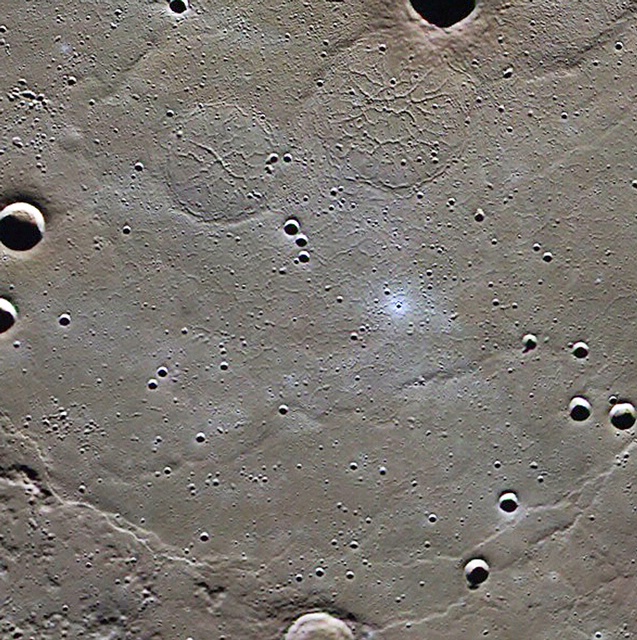-

Goethe Basin on Mercury
Wrinkle-ridges on the floor of Goethe basin on the surface of Mercury.
The margin Goethe basin. A wrinkle-ridge ring marks the margin of the nearly completely buried basin. Graben are found within two interior ridge rings and throughout the basin fill material.
-
MESSENGER Finds Unusual Groups of Ridges and Troughs on Mercury
The MErcury Surface, Space ENvironment, GEochemistry and Ranging (MESSENGER) spacecraft has discovered assemblages of tectonic landforms unlike any previously found on Mercury or elsewhere in the Solar System. The findings are reported in a paper led by Smithsonian scientist Thomas Watters, “Extension and contraction within volcanically buried impact craters and basins on Mercury,” scheduled for publication in the December issue of the journal Geology.
The surface of Mercury is covered with deformational landforms that formed by faulting in response to horizontal contraction or shortening as the planet’s interior cooled and surface area shrank, causing blocks of crustal material to be pushed together. Contraction from cooling of Mercury’s interior has been so dominant that extensional landforms caused by fault formation in response to horizontal stretching and pulling apart of crustal material had not been previously documented outside of the interiors of a few large impact basins. The MESSENGER spacecraft, in orbit around Mercury since March of last year, has revealed families of extensional troughs or graben that are encircled by contractional wrinkle ridges arranged in circular rings. The troughs can form complex patterns varying from the outlines of polygons inside the ridge rings to arcs that parallel the bounding ridges.
“The pattern of wrinkle ridges and graben resembles the raised edge and cracks in a pie crust,” said Watters, geologist at the Center for Earth and Planetary Studies at the Smithsonian’s National Air and Space Museum. “The ‘pie crust’ analogy fits another notable aspect of these collections of tectonic landforms—their association with ‘ghost’ craters.”
Ghost craters are impact craters that have been flooded and buried by lava flows. The thin volcanic deposits overlying the rim of a fully buried impact crater serve to concentrate contractional forces, leading to the formation of a ridge ring that reveals the outline of the buried crater.
“The special arrangement of the wrinkle ridges and graben in many of the ghost craters on Mercury is due to a combination of extensional forces from cooling and contraction of unusually thick lava flow units and contractional forces from cooling and contraction of the planet’s interior,” said Sean Solomon of Columbia University’s Lamont-Doherty Earth Observatory, coauthor and principal investigator of the MESSENGER mission.
The eruption and rapid accumulation of very fluid lava flows into thick cooling units on a planet undergoing a high rate of global contraction may be why these systems of tectonic landforms in ghost craters on Mercury have not been seen elsewhere in the Solar System.
The National Air and Space Museum in Washington, D.C., is located at Sixth Street and Independence Avenue S.W. The Steven F. Udvar-Hazy Center is located in Chantilly, Va., near Washington Dulles International Airport. Both facilities are open daily from 10 a.m. until 5:30 p.m. (closed Dec. 25). Admission is free, but there is a $15 fee for parking at the Udvar-Hazy Center.
-

Graben in Goethe Basin on Mercury
Extensional graben on the floor of Goethe imapact basin on the surface of Mercury.
Large graben in a ghost crater on the floor of the Goethe impact basin. The extensional troughs or graben are up to 2 km wide in this about 47-km-diameter ghost crater. Circumferentially oriented graben crosscut the bounding ridge ring.
-
Quelle:National Air and Space Museum News Media Access
5656 Views
